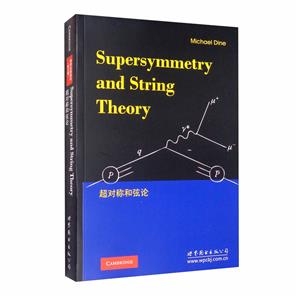-
>
宇宙、量子和人类心灵
-
>
(精)BBC地球故事系列-星际旅行
-
>
从一到无穷大
-
>
图说相对论(32开平装)
-
>
一本有趣又有料的化学书
-
>
刘薰宇的数学三书:原来数学可以这样学全3册
-
>
光学零件制造工艺学
超对称和弦论Supersymmetry and string theory 版权信息
- ISBN:9787510005138
- 条形码:9787510005138 ; 978-7-5100-0513-8
- 装帧:一般胶版纸
- 册数:暂无
- 重量:暂无
- 所属分类:>>
超对称和弦论Supersymmetry and string theory 内容简介
It seems, then, quite likely that a twentyfirst-century particle physicist will re-quire a working knowledge of supersymmetry and string theory, and in writing this extl hope to provide this. The first part of the textis a review of the Standard Model.It is meant to complement existing books, providing an introduction to perturbative ind phenomenological aspects of the theory, but with a lengthy introduction to ion-perturbative issues, especially in the strong interactions. The goal is to provide m understanding of chiral symmetry breaking, anomalies and instantons, suitable ror thinking about possible strong dynamics, and about dynamical issues in super-;ymmetric theories. The first part also introduces grand unification and magnetic rnonopoles. The second part of the book focuses on supersymmetry. In addition to global su-persymmetry in superspace, there is a study of the supersymmetry currents, which are important for understanding dynamics, and also for understanding the BPS con-ditions which play an important role in field theory and string theory dualities. The MSSM is developed in detail, as well as the basics of supergravity and supersym-metry breaking. Several chapters deal with supersymmetry dynamics, including dynamical supersymmetry breaking, Seiberg dualities and Seiberg-Witten theory.The goal is to introduce phenomenological issues (such as dynamical supersymme-try breaking in hidden sectors and its possible consequences), and also to illustrate the control that supersymmetry provides over dynamics. I then turn to another critical element of beyond the Standard Model physics:general relativity, cosmology and astrophysics. The chapter on general relativity is meant as a brief primer. The approach is more field theoretic than geometrical, and the uninitiated reader will learn the basics of curvature, the Einstein Lagrangian,the stress tensor and equations of motion, and will encounter the Schwarzschild solution and its features. The subsequent two chapters introduce the basic features of the FRW cosmology, and then very early universe cosmology: cosmic history,inflation, structure formation, dark matter and dark energy. Supersymmetric dark matter and axion dark matter, and mechanisms for baryogenesis, are all considered. The third part of the book is an introduction to string theory. My hope, here, is to be reasonably comprehensive while not being excessively technical. These chapters introduce the various string theories, and quickly compute their spectra and basic features of their interactions. Heavy use is made of light cone methods. The full machinery of conformal and superconformal ghosts is described but not developed in detail. but conformal field theory techniques are used in the discussion of string interactions. Heavy use is also made of effective field theory techniques, both at weak and strong coupling. Here, the experience in the first half of the text with supersymmetry is invaluable; again supersymmetry provides a powerful tool to constrain and understand the underlying dynamics. Two lengthy chapters deal with string compactifications; one is devoted to toroidal and orbifold compactifications,which are described by essentially free strings; the other introduces the basics of Calabi-Yau compactification. Four appendices make up the final part of this book.
超对称和弦论Supersymmetry and string theory 目录
A note on choice of metric
Text website
Part 1 Effective field theory: the Standard Model,
supersymmetry, unification
1 Before the Standard Model
Suggested reading
2 The Standard Model
2.1 Yang-Mills theory
2.2 Realizations of symmetry in quantum field theory
2.3 The quantization of Yang-Mills theories
2.4 The particles and fields of the Standard Model
2.5 The gauge boson masses
2.6 Quark and lepton masses
Suggested reading
Exercises
3 Phenomenology of the Standard Model
3.1 The weak interactions
3.2 The quark and lepton mass matrices
3.3 The strong interactions
3.4 The renormalization group
3.5 Calculating the beta function
3.6 The strong interactions and dimensional transmutation
3.7 Confinement and lattice gauge theory
3.8 Strong interaction processes at high momentum transfer
Suggested reading
Exercises
4 The Standard Model as an effective field theory
4.1 Lepton and baryon number violation
4.2 Challenges for the Standard Model
4.3 The hierarchy problem
4.4 Dark matter and dark energy
4.5 Summary: successes and limitations of the
Standard Model
Suggested reading
5 Anomalies, instantons and the strong CP problem
5.1 The chiral anomaly
5.2 A two-dimensional detour
5.3 Real QCD
5.4 The strong CP problem
5.5 Possible solutions of the strong CP problem
Suggested reading
Exercises
6 Grand unification
6.1 Cancellation of anomalies
6.2 Renormalization of couplings
6.3 Breaking to SU(3) x SU(2) x U(1)
6.4 SU(2) x U(1) breaking
6.5 Charge quantization and magnetic monopoles
6.6 Proton decay
6.7 Other groups
Suggested reading
Exercises
7 Magnetic monopoles and solitons
7.1 Solitons in 1 + 1 dimensions
7.2 Solitons in 2 + 1 dimensions: strings or vortices
7.3 Magnetic monopoles
7.4 The BPS limit
7.5 Collective coordinates for the monopole solution
7.6 The Witten effect: the electric charge in the
presence of 0
7.7 Electric-magnetic duality
Suggested reading
Exercises
8 Technicolor: a first attempt to explain hierarchies
8.1 QCD in a world without Higgs fields
8.2 Fermion masses: extended technicolor
……
Part 2 Supersymmetry
Part 3 String theory
Part 4 The appendices
References
Index
超对称和弦论Supersymmetry and string theory 作者简介
Michael Dine,美国加利福尼亚大学(University of California)教授。
- >
我从未如此眷恋人间
我从未如此眷恋人间
¥37.4¥49.8 - >
史学评论
史学评论
¥18.5¥42.0 - >
唐代进士录
唐代进士录
¥17.1¥39.8 - >
诗经-先民的歌唱
诗经-先民的歌唱
¥15.1¥39.8 - >
伯纳黛特,你要去哪(2021新版)
伯纳黛特,你要去哪(2021新版)
¥23.4¥49.8 - >
伊索寓言-世界文学名著典藏-全译本
伊索寓言-世界文学名著典藏-全译本
¥6.1¥19.0 - >
名家带你读鲁迅:朝花夕拾
名家带你读鲁迅:朝花夕拾
¥10.5¥21.0 - >
中国历史的瞬间
中国历史的瞬间
¥23.5¥38.0
-
相对论
¥10.2¥32 -
数学物理方法
¥13.2¥27 -
2022图书×抽奖盲袋
¥9.9¥25 -
2023读书月阅读盲盒——天黑,闭眼,刀谁?
¥42.3¥158 -
2022读者节纪念徽章-三星会员专属
¥45¥45.6















